Module 3 features another case study. In it, a day nurse removes a catheter, based on her facility’s nurse-driven protocol. Doing so leads to a difficult conversation with the night shift nurse. In the process, learners see issues connected to communication and culture around catheter use.
Time required: 7 minutes
Potential Questions To Ask Before You Begin
- How does the learner communicate with other shifts? Is there ever a miscommunication? If so, how is it handled?
- What does the learner think about nurse-driven protocols related to urinary catheter use?
Content Delivery Instructions
- Note that the following slide has instructions to stop and reflect on questions:
- Slide 3 (slide header is “Is This the Right Call?”)
- Slide 6 (slide header is “Questions For You”)
Module 3 Content
Slide 1: Preventing CAUTI in the ICU Setting
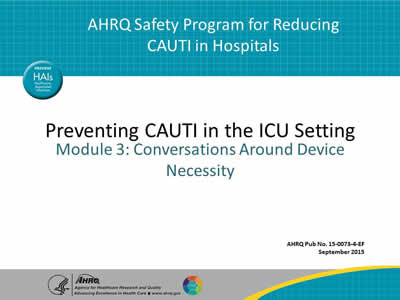
Narration:
In Module 1, we discussed the indications for an indwelling urinary catheter, the causes of catheter-associated urinary tract infections, or CAUTI, in the intensive care unit, or ICU, as well as methods to mitigate the risk of CAUTI. In Module 2, you learned about the importance of observation and communication, both about placing the urinary catheter bag and using a securement device.
In this module, we will look at a case scenario involving communication between a day nurse and a night nurse.
Potential points for discussion or questions from the learner:
- None
Slide 2: Setting the Stage

Narration:
Let’s begin with the case study.
This ICU had a high urinary catheter utilization rate that might have contributed to high CAUTI rates. Three months ago, the ICU implemented a nurse-driven indwelling catheter removal protocol, which included removing catheters that met criteria defined in the protocol. This was a major change for the nursing staff.
Sally was new to the ICU and was very engaged.
Sally identified that Ms. X, a patient on a ventilator, no longer required a urinary catheter. She implemented the nurse-driven protocol because there was no need for hourly output measurement. In addition, the patient was awake, alert, and able to void using a female urinal or bedpan. Sally noted that the patient was on a chronic diuretic, but it was not being adjusted. She removed the catheter according to the protocol, with no exceptions noted, after discussing solutions with the team. In case the patient developed incontinence, Sally placed an absorbent pad under Ms. X and instructed her on how to call the nurse when the bedpan was needed.
Potential points for discussion or questions from the learner:
- To this point, what does the learner think about the scenario? Does anything like this happen in his/her facility?
Slide 3: Is This the Right Call?
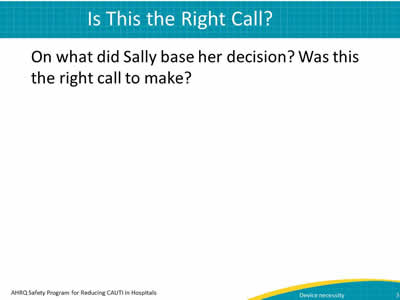
Narration:
Pause the presentation and think: Was this the right decision? What elements of the situation led Sally to make her decision?
You might have noted several key factors:
First, there was no need for hourly outputs.
Second, Ms. X was awake, alert, and able to void using a female urinal or a bedpan.
Third, although Ms. X was on a chronic diuretic, which would lead to high urinary output, it was not being adjusted.
Potential points for discussion or questions from the learner:
- Pause the presentation, as instructed, and discuss the questions.
Slide 4: The Next Morning: Molly

Narration:
That night, Molly arrived for the night shift. Molly was an experienced nurse and had worked in the ICU for 15 years. When conducting her patient rounds, she found Ms. X was incontinent. The urine had soaked through the pad, onto the bed, and even on her stockings. Shortly after the bed was changed, Ms. X was incontinent again. Molly was very upset.
Potential points for discussion or questions from the learner:
- Has the learner ever been in Molly’s position? Or in Sally’s?
Slide 5: What Do You Think Will Happen?

Narration:
The next morning when Sally arrived at work, Molly reprimanded her.
(Dialogue between two females)
Molly: I can’t believe you pulled the catheter on Ms. X. She was incontinent all night, and I’m afraid her skin will break down. What were you thinking?
Sally: I was following the nurse-driven protocol, and she didn’t meet criteria for continued catheter use. I put a pad under her and instructed her on how to ring for the bedpan.
Molly: I think you better brush up on your nursing skills because that showed a complete disregard for patient dignity. I’m reporting this to management.
Sally: I’m sorry you had such a difficult night, but I did run the situation by the team and they all agreed with my decision. Sounds like we need to talk this over with our manager.
Potential points for discussion or questions from the learner:
- How did this conversation go? Has the learner experienced anything like it? How did it make him/her feel?
Slide 6: Questions for You
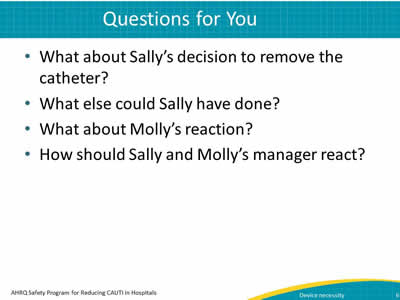
Narration:
Think back to the points we discussed about Sally’s decision. Did you agree with her? Was she right to remove the catheter? What other actions might Sally have taken? Was Molly’s behavior appropriate? What might the manager do to mitigate this situation?
Ask yourself: Could this have happened in my ICU?
Pause the presentation and think about these questions. Once you’ve considered them, resume playing the presentation.
Potential points for discussion or questions from the learner:
- Because subsequent slides will discuss each question, have the learner write down what he/she thinks on these points.
Slide 7: Discussing the Decision

Narration:
Did you agree with the decision to remove the catheter?
Nurses are busy, and for many nurses, removing a catheter is a change in practice. Clearly, Ms. X met criteria for removal according to the protocol. Although these are difficult decisions, it is important to keep the overall goal in mind. Continued use of an indwelling catheter can lead to a CAUTI which may also result in bacteremia and sepsis. In addition, antibiotic treatment for the CAUTI can put the patient at risk for multiple drug-resistant organisms or Clostridium difficile.
Potential points for discussion or questions from the learner:
- Did the learner agree with the decision? Why or why not?
Slide 8: Discussing the Communication
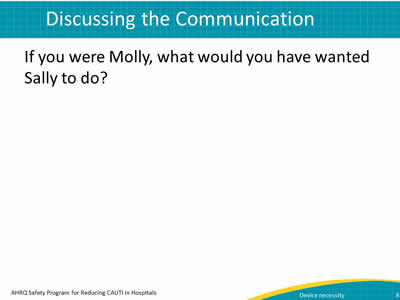
Narration:
What other actions might Sally have taken?
Sally could have communicated better. In the handoff between shifts, Sally could have reported to the night staff that the catheter was removed during the day because Ms. X no longer met criteria for continuation of the urinary catheter. Additionally, she could have shared the alternative strategies that she put in place, which were use of the bedpan and absorbent pads.
Additional interventions may have included offering the bedpan or female urinal at scheduled intervals.
Last, engaging the family was important, as family members can reinforce the plan of care.
Potential points for discussion or questions from the learner:
- Does the learner think that communication could have been handled better? Has the learner experienced a communication breakdown in another situation? How did he/she react?
Slide 9: Discussing the Behavior
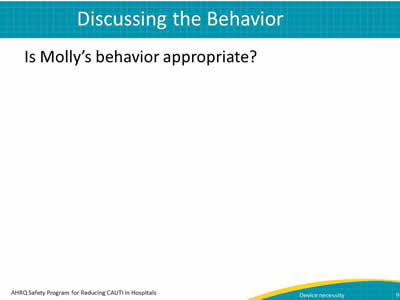
Narration:
Was Molly’s behavior appropriate?
No. Although Molly’s concern for patient dignity was well-meaning, Sally’s decision followed department protocol. Change in practice can be difficult, so this situation was an opportunity for staff to discuss the plan of care.
Potential points for discussion or questions from the learner:
- Does the learner agree that Molly’s behavior was inappropriate?
Slide 10: The Manager's Reaction

Narration:
What might the manager do to mitigate this situation?
Janet, the manager, should take the opportunity to talk with Molly about the situation and make some recommendations.
(Dialogue between two females)
Janet: Molly, Sally told me about your concerns for Ms. X.
Molly: I can’t believe she did that. Poor Ms. X was probably uncomfortable all night.
Janet: I completely understand your position. But, would you agree that patient safety is our highest priority?
Molly: (Pauses) Yes, obviously, but…
Janet: Well, our indwelling catheter utilization rate has historically been in the 90th percentile as compared with similar type ICUs. Would you agree that’s pretty high?
Molly: Yes.
Janet: I do, too. However in the last 3 months, since we initiated the nurse-driven protocol, it’s dropped to the 50th percentile.
Molly: Wow, that’s a big change. I had no idea.
Janet: I know we have more opportunities for improvement, and there may be times when the catheter has to be reinserted, but every patient who meets the criteria deserves that chance. You are an important part of this process.
I tell you what. How about you and some of the other personnel develop a communication tool so that changes in catheter use and alternative approaches are communicated clearly between shifts?
Molly: I like that idea. Thanks for letting me be involved.
Potential points for discussion or questions from the learner:
- How does the learner feel this conversation went?
Slide 11: Summary
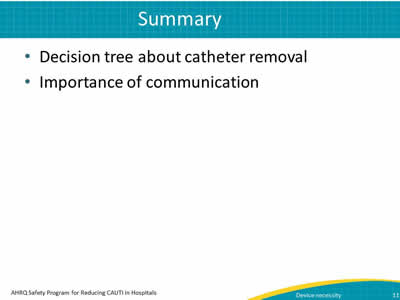
Narration:
So, what did you learn in this module?
We started off by looking at a scenario that dealt with the decision process for whether to remove a urinary catheter. Next, we learned the importance of good communication related to catheter removal. In our scenario, Molly raised valid concerns regarding patient dignity. However, Sally’s decision to remove the catheter was based on a unit protocol which optimizes patient safety. It is also important to remember that catheter removal can improve a patient’s comfort and mobility, thereby also contributing to patient dignity.
Potential points for discussion or questions from the learner:
- Does the learner have any questions about the module?



